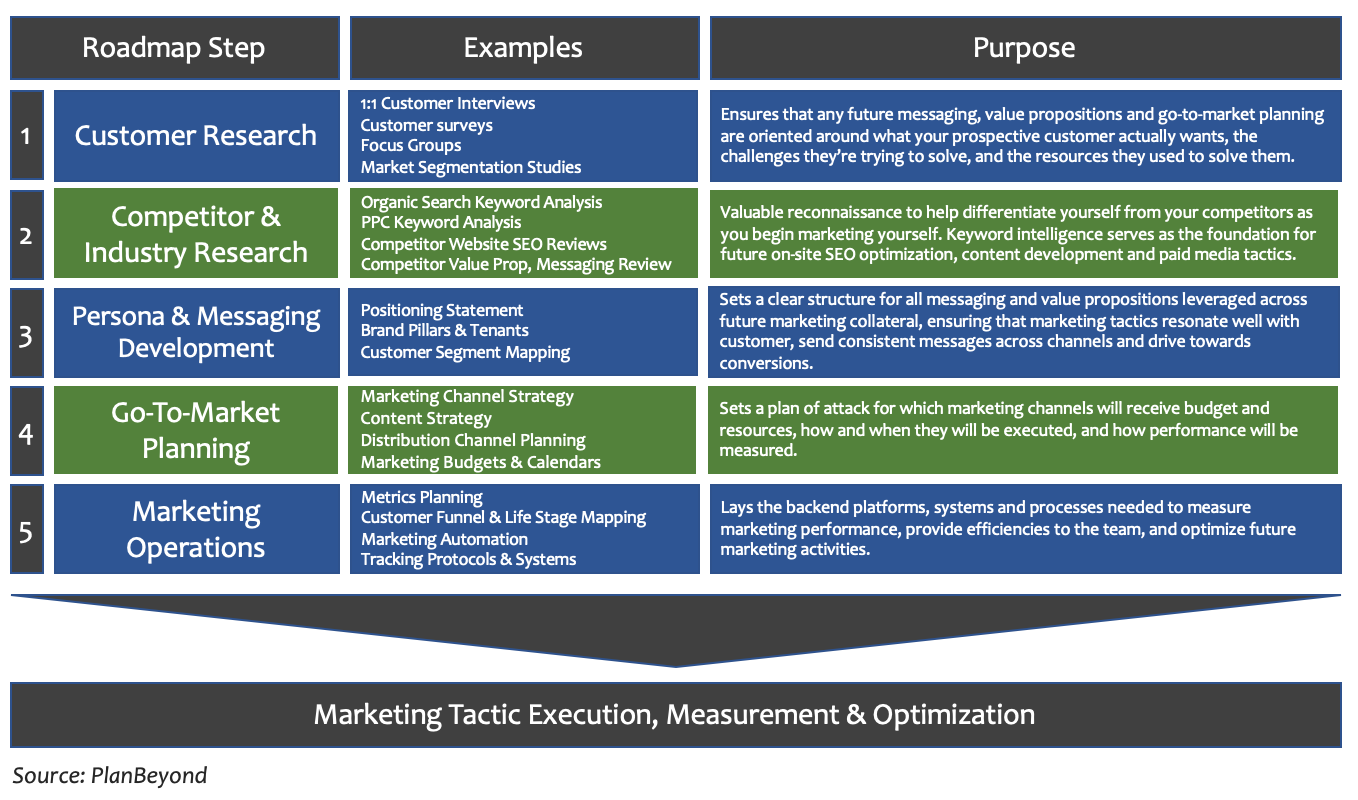Just about any company ready to hit the ground running and attract new customers asks, “What marketing should we do?” But, the real question should actually be, “What’s the right marketing strategy for my business?”
No matter how seemingly good or clever your marketing might be, without the right marketing strategy in place, these efforts can fall on blind eyes or deaf ears. Having the right marketing strategy not only gives organizations the confidence in their tactics but it drastically increases their ability to successfully acquire new customers.
Understanding Marketing Strategy
A great marketing strategy is anchored in a series of discrete steps, each of which builds on previous steps to take business leaders down a logical, rational path to marketing tactic execution. Let’s go through the roadmap below to cover what each of these steps entails.

Customer Research
The first step in solid marketing strategy is knowing who your customer is, and who your customer isn’t! You’ll have no idea if the messaging you want to use or the marketing channels you want to leverage will work if you don’t know what it is that drives your customer to make purchase decisions and how your customer thinks about your brand, your product or even your general category.
Performing customer research helps you get to the heart of these very issues. Of course, you’ll need to make sure you select the right market research tactic. Qualitative interviews can be an excellent approach when you’re just starting to explore a subject and you need to ask broad, open-ended questions to understand complex topics that you don’t know very much about. In contrast, select customer surveys when you have a relatively strong understand of your market or customers and you need data to validate trends or assumptions that are based on anecdotal evidence.
At this stage, customer segmentation work is often extraordinarily valuable to help pinpoint exact segments of a customer market you want to directly go after. By knowing which subset of a broader market you want to penetrate, you’ll have clearer direction about messaging, tactics and even distribution channels that will result in stronger acquisition.
Competitor & Industry Research
Creating a differentiated product or service is necessary to help you stand apart from your competition. How can you differentiate yourself if you don’t know where everyone else stands? Performing competitor and industry audits is an objective way of assessing the market and beginning to see what role you can stake out.
This type of work can take a variety of forms, including:
-
Competitor messaging: Exploring how your competitors define themselves and their benefits will isolate the key value propositions organizations are using to differentiate themselves, as well as benefits that might just be table stakes in your particular industry.
-
Organic keyword search analysis: Don’t you want to know how prospective customers search for your type of products and services? Identifying their behavior informs key aspects of website design to increase the likelihood of being found.
-
Paid keyword search: You may want to do Google or Bing Ads, but do you know what words to bid on? Or if it will even work? Doing a little recon on how competitors are using search engines to advertise and bid on keywords will help inform your future marketing tactics.
While by no means an exhaustive list, these types of competitor and industry audits go a long way to educating organizations about what they’re up against, showing them a way to carve a clear niche for themselves in a particular industry, and setting the stage for future marketing activities.
Persona & Messaging Development
What tagline will your customers love? What benefits will you choose to tout again and again?
Persona and messaging work helps defines these very things. They ensure that you always have your core customer top-of-mind and that you hit on consistent messages repeatedly so that they begin to take hold in prospective customers’ minds.
Defining your core persona(s) is what what naturally follows from customer research. After asking questions about professional and personal goals, KPIs, business challenges and professional ambitions, you’ll have a clear picture of who your customer is. Write it down! Codify it so that anyone working on future marketing tactics knows exactly who the audience is and what drives them.
Relatedly, you’ll need to define what your brand stands for, which means developing a positioning statement and brand pillars. As we’ve written before, a positioning statement expressly defines who your target customer is, what they are looking for, the unique benefit you offer, and why you are unique from your competition. Meanwhile, brand pillars are the key value propositions you will offer your customers to back-up your positioning statement.
Why do what seems like “fluffy” work? Because it matters. Business positioning and brand pillars gives you the fundamental foundation for any and all subsequent marketing work. They are the North Stars that let you assess if any marketing collateral you develop aligns with your broader marketing strategy.
Go To Market Planning
Go to marketing planning is as close as you get to actual marketing tactics during the marketing strategy process. It’s the time when you sit down and determine exactly which marketing tactics you plan to leverage, which marketing channels make sense or don’t make sense for your business, when you’ll execute on those tactics, and the resources you’ll need to get it all down. Frankly put, it’s your marketing game plan.
This is a critical phase that will help you determine what budget you’ll need, who you need to hire to your team, and what agencies, vendors or contractors you’ll need to execute against your plan. This is also when you start developing your high-level marketing calendar as well as calendars for individual marketing channels or campaigns.
The go to market stage is the place where you establish broader goals for your marketing activities. This can be everything from building brand awareness, driving new customer acquisition, improving customer retention, or some other quantitative goal.
Marketing Operations
Often the least-frequently-discussed part of marketing strategy is marketing operations. This involves a lot of back-end word to make sure you have the right processes in place to execute your marketing activities smoothly and actually measure their performance. At this stage, you’ll assess what types of tools or software you’ll need, which can include email platforms, marketing automation tools or CRM software.
During the marketing operations stage, you’ll also start looking at customer life stages, and begin defining what it will take to move prospective customers down your sales funnel, and what types of activities to leverage depending upon their life stage. You’ll also define what key analytics you want to track and begin creating processes for being able to measure and record them.
What Happens After Marketing Strategy
Once you tackle these five critical areas of marketing strategy, you are ready to hit the ground running and start executing your marketing plan. With this strategy under your belt, you’ll know exactly who your customer is, what your customer cares about, how your business will differentiate itself, the marketing channels needed to attract your customers, the budget and tools needed for proper execution, and how you’re going to measure your performance.
From here the fun begins! Now you get to start actually launching your marketing campaign and see your plans come to fruition.






